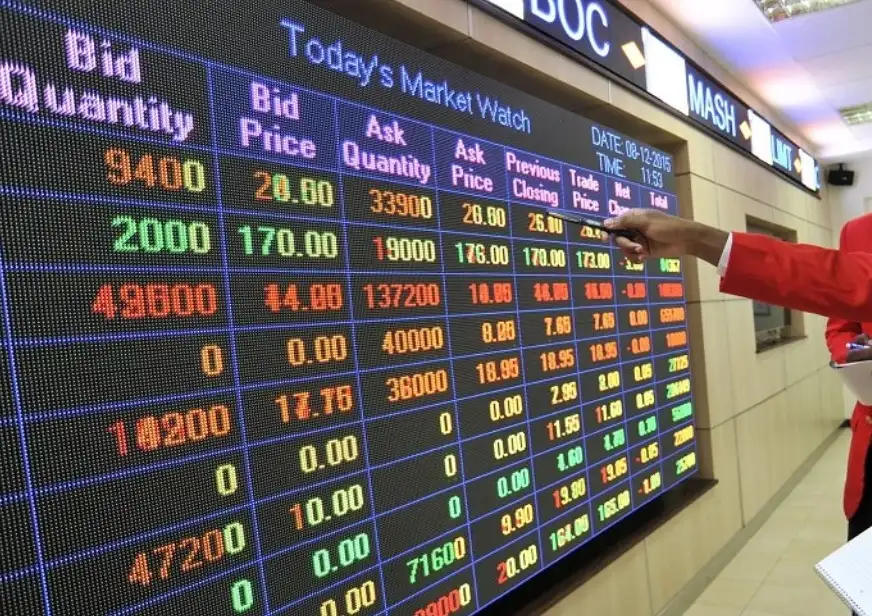The dynamics of equity trading at the Nairobi Securities Exchange (NSE) are undergoing a significant transformation. Foreign investor activity has dropped to its lowest level in fifteen years, signalling not just a cyclical retreat but possibly a structural shift in how Kenya’s capital markets operate. According to data from the Capital Markets Authority (Kenya) (CMA), foreign participation in total equity turnover fell to 28.01 % in September 2025, down from 31.28 % in August. The last time participation reached this low level was in August 2010, when it stood at around 21.8 %.
Over the full third quarter of 2025, foreign investor participation averaged 30.12 %, marking a dramatic drop from approximately 46.68 % in Q2. Broadly, foreign investors purchased KSh 11.76 billion (about USD 91 million) and sold KSh 15.06 billion (about USD 117 million), resulting in a net outflow of KSh 3.84 billion (circa USD 30 million).
Build the future you deserve. Get started with our top-tier Online courses: ACCA, HESI A2, ATI TEAS 7, HESI EXIT, NCLEX-RN, NCLEX-PN, and Financial Literacy. Let Serrari Ed guide your path to success. Enroll today.
“The drop was most likely a mix of profit-taking and portfolio re-balancing after a large rally,” the CMA reported, while cautioning that “ongoing foreign outflows pose a sustained risk to market stability, emphasising the importance of implementing targeted measures to enhance liquidity and stimulate investor activity at the NSE.”
This dramatic shift has coincided with rising local investor participation, policy reforms such as “single-share trading”, and a backdrop of both global uncertainty and domestic change. What does this mean for Kenya’s market, its investors and its future?
The Numbers, The Shift and What’s Behind Them
Foreign participation: The fall
The figures speak for themselves. Foreign participation in Kenya’s equities market has come off sharply. While data for September 2025 show a 28.01 % share, recent quarterly data provide context: the second quarter of 2025 saw an average foreign participation of 46.68 %. These numbers match with publicly reported figures from financial-data outlets. For example, one article noted that foreign investor participation rose to 46.68 % in Q2, up from 38.24 % in Q1.
This suggests that the decline to ~30 % or below is not a minor blip but a marked transition. It also indicates that foreign investors are increasingly stepping back or reallocating away from low-liquidity or frontier markets like Kenya.
Why are foreign investors stepping back?
Several factors help explain this retreat:
- Profit-taking and market rally exhaustion. After a period of strong gains in Kenya’s listed equities, many foreign institutions appear to have locked in gains. The CMA itself flagged this as one driver of the recent drop.
- Global risk and frontier-market sensitivity. Frontier markets like Kenya are highly sensitive to global shocks—rising interest rates in major economies, currency instability, trade tensions and geopolitical risk all weigh heavily. For example, an earlier report noted that in Q1 2025 foreign participation had dropped to 38.24 % amid concerns of US-tariffs and global uncertainty.
- Local regulatory or structural friction. Although Kenya has opened up segments of its market (such as full foreign ownership of listed firms), institutional investors often demand market depth, robust investor protection, transparent corporate governance and reliable exit mechanisms—all of which can be more challenging in frontier contexts.
- Domestic investor surge and market micro-structure change. As local investors become more active, trading behaviours may change; the roles of foreign institutional players may shift accordingly. The rise in local trading may reduce relative foreign share even if foreign volumes remain constant.
Local investor momentum: The flip side
Despite the decline in foreign participation, Kenya’s market is not stagnating. In fact, the equity market had its strongest quarter in four years in Q3 2025: investor paper wealth rose by KSh 360 billion (about USD 2.80 billion), lifting overall market capitalisation to KSh 2.78 trillion (around USD 21.5 billion)—up 14.7 % from Q2.
Indices registered substantial gains: the NSE 20 Index jumped 21.8% to 2,972.64 points, while the NASI Index climbed 35% to 176.7 points. The CMA attributed part of the local surge to increased retail participation, helped by the reform allowing investors to buy as little as one share.
Additionally, the fixed-income market has anchored broader investor activity. Secondary-market turnover in bonds reached KSh 2 trillion (USD 15.5 billion) by September, already exceeding full-year 2024 levels by over 30%. Treasury bond issuance in September alone hit KSh 250 billion (USD 1.94 billion), bringing year-to-date issuance to KSh 713.15 billion (USD 5.52 billion) – nearly triple oversubscription for some auctions. Corporate-bond turnover rebounded sharply from KSh 1.2 million to KSh 105 million (USD 812,000) in that same period.
These trends suggest investors are shifting toward debt instruments—valued for predictability and yield—while local equity participation rises and foreign equity flows decline.
Structural Implications for Kenya’s Capital Markets
Reduced reliance on foreign capital
A decline in foreign investor share could mean Kenya’s market is becoming less reliant on external capital flows. On one hand, this may reduce vulnerability to sudden global shocks or mass foreign exits. On the other hand, foreign institutions bring valuable scale, market-making ability, global network access and analytical discipline—so their retreat could affect depth and liquidity.
Liquidity and volatility risks
Foreign institutional participation often enhances liquidity, particularly in large-cap stocks and for bulk trades. A lower foreign presence may reduce trading volumes in high-value shares, widen bid-ask spreads and lead to higher volatility. The CMA has implicitly flagged this risk by emphasising “market stability” concerns.
Evolving investor base
With increased local participation—both institutional and retail—the profile of trading may change. Retail investors typically trade smaller volumes, may be more reactive than strategic, and often focus on large-cap names or popular sectors. If trading becomes more domestically driven, behaviour may shift: higher turnover but smaller average size, possibly higher sensitivity to local news, and lower involvement of global thematic capital.
Product and market depth limitations
For long-term development, deep markets need diversified instruments (derivatives, ETFs, structured products), strong governance, efficient clearing and settlement, and above-average liquidity. A decline in foreign participation may limit the impetus or resource for developing such products, unless local investors or regulators assume the mantle.
Competition in the region
Kenya doesn’t operate in a vacuum. Other exchanges in Africa—such as those in Nigeria and Egypt—are vying for institutional capital. As one report noted, Kenya’s relative appeal may weaken if foreign investors reallocate within Africa. Investors seeking frontier-market exposure may judge other destinations as higher-potential, reducing capital directed to Kenya.
One decision can change your entire career. Take that step with our Online courses in ACCA, HESI A2, ATI TEAS 7, HESI EXIT, NCLEX-RN, NCLEX-PN, and Financial Literacy. Join Serrari Ed and start building your brighter future today.
What’s Driving the Push Toward Domestic Investors?
Reforms to broaden access
One pivotal change has been the introduction of single-share trading: the ability for investors to buy as little as one share, rather than being constrained by high minimum-lot sizes. This lowers entry barriers for retail investors and helps democratise equity investing. The CMA cited this reform as one of the factors behind increased local participation.
Technology and inclusion
Kenya has a strong fintech ecosystem (driven in part by the mobile-money momentum) which helps channel more Kenyan investors into capital markets. Digital brokerage platforms, mobile trading apps and greater financial-literacy outreach support this trend. As local retail participation rises, the market’s composition shifts.
Domestic institutional investor growth
Local institutional investors—pension funds, insurance companies, collective investment schemes—are increasingly active. With foreign participation dropping, domestic institutions may take greater responsibility for liquidity and capital-market health. For example, reports show a sizeable increase in unit-trust assets under management in recent quarters.
Macro-economic and policy dynamics
Global risk, currency pressure, debt stress and regional instability may make foreign investors more cautious about frontier equities. In contrast, domestic investors may have more detailed local knowledge, lower currency hedging costs and longer-term domestic growth orientation. Combined with reforms and access improvements, local investors may fill gaps left by foreign headwinds.
Risks and Watch-Points for Market Participants
Potential for foreign-flow reversals
While foreign participation is currently low, a recovery in global risk appetite could reverse the trend—but that may bring volatility rather than stability. A sudden return could increase competition for listings, push valuations higher rapidly, and then open the door to equally rapid exits. Continuous net foreign outflows may risk weakening liquidity, but sudden inflows can also destabilise if not managed.
Concentration risk and market-cap bias
With fewer participants and less foreign involvement, trading may concentrate in a handful of large-cap stocks (e.g., major banks, telecoms). Without broad participation or mid-cap engagement, the market may become less diversified, more correlated and more sensitive to idiosyncratic risks. Smaller companies may struggle for depth, hampering growth and listing pipelines.
Liquidity bottlenecks
Lower foreign engagement may reduce volume in highly liquid stocks and reduce the ability to absorb large trades without price impact. For institutional investors, this may make Kenya less attractive for large allocations or passive strategies. The risk is that local investors may not fully substitute for foreign scale.
Macro, currency and policy risks
Kenya’s economy faces familiar headwinds—currency depreciation, inflation, rising debt servicing, political uncertainty and regional spill-over risk. These factors weigh on investor confidence. For example, one regional analysis pointed to Kenya’s weaker PMI, higher borrowing and other macro constraints as dampeners on foreign investment appetite.
Regional competition for capital
If Kenya’s market is perceived as less liquid or less attractive compared with peer African exchanges, capital may flow elsewhere. The outflow of institutional capital to other African markets remains a potential competitive risk.
What to Monitor Going Forward
To assess how this transition evolves, stakeholders should monitor several key indicators and signals:
- Foreign-participation metrics: Monthly or quarterly foreign share of equity turnover and net foreign flows should be tracked closely.
- Liquidity and turnover statistics: Whether trading volumes remain robust and whether bid-ask spreads stay narrow will be indicators of market health.
- Domestic investor growth: Rise in number of retail/institutional accounts, average ticket size, turnover by local participants and share of trading by sector.
- New product launches and market-structure reforms: Introduction of new instruments (e.g., ETFs, derivatives), reduction of fees, improved clearing/settlement, stronger corporate-governance frameworks.
- Macro-economic and policy environment: Inflation, currency stability, debt servicing, fiscal policies, and regional/geopolitical stability.
- Regional comparative flows: Whether institutional capital is being allocated to Kenya relative to peer African markets and whether Kenya retains competitiveness for listings or foreign equity allocations.
Implications for Key Stakeholders
Domestic and foreign investors
- Domestic investors may find more fertile ground as barriers fall and access broadens; however, increased competition among locals may also raise valuations and reduce bargains.
- Foreign investors need to reassess their allocation strategy for Kenya: lower participation might mean less competitive pressure, but it also may mean thinner liquidity and less capacity for large trades. They may seek strategic positions rather than purely trading flows.
Listed companies
Companies listed on NSE must adapt to a changing investor base. With a growing local investor cohort, communication, local investor relations, corporate governance and transparency become critical. Moreover, firms might need to engage more effectively with domestic asset managers and retail channels rather than relying solely on foreign capital.
Regulators and market operators
The CMA and NSE have to respond proactively to this shift. They must balance support for domestic investor growth while ensuring foreign investor accessibility, maintaining market depth, liquidity, fairness and stability. Policy reforms that enhance access, reduce costs, enforce governance and diversify products will be key.
Broader economy and capital-market role
The shift suggests that Kenya’s equity markets are maturing, moving toward a model less dependent on foreign capital and more rooted in local investor participation. If well-managed, this could strengthen resilience and align capital markets more closely with domestic economic growth. Conversely, if foreign outflows persist without substitution, the market could face challenges in funding, depth and growth.
The Big Picture: Kenya’s Market at a Crossroads
In many ways, Kenya’s equity market stands at a crossroads. On one path is the traditional model: heavy reliance on foreign institutional capital, large trades, global flows and frontier-market fixes. On the other path is a more domestically anchored model: democratized access, higher retail participation, local institutional growth and a market shaped more by domestic trends than global cycles.
The decline in foreign participation to ~28 % is more than just a statistic—it may be a signal that the frontier-market narrative is shifting. Kenya’s reforms (such as single-share trading), technology uptake, fintech ecosystem and local investor base all point toward a market that is evolving into something different. Whether this is a positive development depends on execution: whether local liquidity deepens, whether product diversity expands, whether governance standards remain high, and whether Kenya can remain competitive for regional capital flows.
Importantly, this transition also raises strategic questions: Will Kenya become less exposed to global shocks, or simply find itself with fewer resources to absorb them? Will local investors fill the void left by foreign institutions, or will market depth and sophistication diminish? Will Kenya’s capital market become more inclusive and resilient, or will it shrink in relevance on the global frontier ladder?
For Kenya to succeed in this next phase, a few things must happen: strong regulatory standards, deeper domestic participation (both retail and institutional), better liquidity management, diversified products, and healthy domestic-foreign investor balance. If those elements align, Kenya could leap from being a frontier outpost to being a regional capital-markets hub anchored on domestic strength.
Conclusion
The shift in foreign investor participation—plunging to the lowest level in fifteen years—is a major event for Kenya’s capital-markets story. It is both a warning and an opportunity: a warning that reliance on foreign flows brings inherent vulnerability, and an opportunity to re-engineer the market around deeper domestic participation.
For investors, listed firms, regulators and the economy as a whole, the coming quarters will be crucial. Monitoring how domestic participation evolves, how foreign flows respond and how policy and market structure adapt will determine whether this era becomes one of renewal, reform and resilience—or of muted global relevance.
Kenya’s capital-markets evolution might just be entering a new chapter—one that demands attention, adaptation and strategic vision.
Ready to take your career to the next level? Join our Online courses: ACCA, HESI A2, ATI TEAS 7 , HESI EXIT , NCLEX – RN and NCLEX – PN, Financial Literacy!🌟 Dive into a world of opportunities and empower yourself for success. Explore more at Serrari Ed and start your exciting journey today! ✨
Track GDP, Inflation and Central Bank rates for top African markets with Serrari’s comparator tool.
See today’s Treasury bonds and Money market funds movement across financial service providers in Kenya, using Serrari’s comparator tools.
photo source: Google
By: Montel Kamau
Serrari Financial Analyst
31st October, 2025
Article, Financial and News Disclaimer
The Value of a Financial Advisor
While this article offers valuable insights, it is essential to recognize that personal finance can be highly complex and unique to each individual. A financial advisor provides professional expertise and personalized guidance to help you make well-informed decisions tailored to your specific circumstances and goals.
Beyond offering knowledge, a financial advisor serves as a trusted partner to help you stay disciplined, avoid common pitfalls, and remain focused on your long-term objectives. Their perspective and experience can complement your own efforts, enhancing your financial well-being and ensuring a more confident approach to managing your finances.
Disclaimer: This article is for informational purposes only and does not constitute financial advice. Readers are encouraged to consult a licensed financial advisor to obtain guidance specific to their financial situation.
Article and News Disclaimer
The information provided on www.serrarigroup.com is for general informational purposes only. While we strive to keep the information up to date and accurate, we make no representations or warranties of any kind, express or implied, about the completeness, accuracy, reliability, suitability, or availability with respect to the website or the information, products, services, or related graphics contained on the website for any purpose. Any reliance you place on such information is therefore strictly at your own risk.
www.serrarigroup.com is not responsible for any errors or omissions, or for the results obtained from the use of this information. All information on the website is provided on an as-is basis, with no guarantee of completeness, accuracy, timeliness, or of the results obtained from the use of this information, and without warranty of any kind, express or implied, including but not limited to warranties of performance, merchantability, and fitness for a particular purpose.
In no event will www.serrarigroup.com be liable to you or anyone else for any decision made or action taken in reliance on the information provided on the website or for any consequential, special, or similar damages, even if advised of the possibility of such damages.
The articles, news, and information presented on www.serrarigroup.com reflect the opinions of the respective authors and contributors and do not necessarily represent the views of the website or its management. Any views or opinions expressed are solely those of the individual authors and do not represent the website's views or opinions as a whole.
The content on www.serrarigroup.com may include links to external websites, which are provided for convenience and informational purposes only. We have no control over the nature, content, and availability of those sites. The inclusion of any links does not necessarily imply a recommendation or endorsement of the views expressed within them.
Every effort is made to keep the website up and running smoothly. However, www.serrarigroup.com takes no responsibility for, and will not be liable for, the website being temporarily unavailable due to technical issues beyond our control.
Please note that laws, regulations, and information can change rapidly, and we advise you to conduct further research and seek professional advice when necessary.
By using www.serrarigroup.com, you agree to this disclaimer and its terms. If you do not agree with this disclaimer, please do not use the website.
www.serrarigroup.com, reserves the right to update, modify, or remove any part of this disclaimer without prior notice. It is your responsibility to review this disclaimer periodically for changes.
Serrari Group 2025












